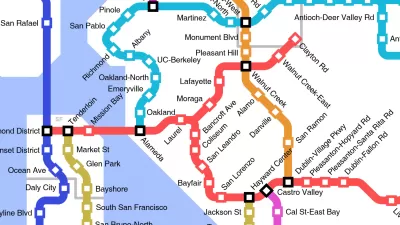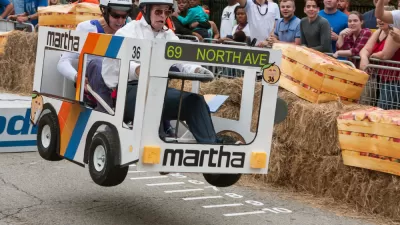A failed demolition has created a new, albeit temporary, landmark for Dallas.
Is this the most Internet famous demolition since a MARTA bus blocked the Georgia Dome implosion in 2017? Probably.
"The Leaning Tower of Dallas was still leaning Monday — but it’s expected to tumble before long," write Nataly Keomoungkhoun and Catherine Marfin.
"After Sunday’s implosion of an 11-story tower on Haskell Avenue near downtown Dallas failed to bring down the center of the structure, the lopsided landmark immediately became an internet sensation," explain Keomoungkhoun and Marfin for context. "As video of the partial collapse spread, people began posting pictures of themselves pretending to prop up what remained of the former Affiliated Computer Services building."

The news of the buildings predicament spread as far as Houston, where the Houston Chronicle picked up Associated Press coverage of the viral sensation.
Back in Dallas, Dallas Morning News architecture critic Mark Lamster devoted serious intellectual effort to excavating a narrative from the wreckage. "Project onto it whatever Dallas narrative you like," writes Lamster.
It’s a symbol of our demolition culture and disrespect for history. It’s a testament to private sector incompetence (I mean, seriously) and public sector negligence (who allowed this to go down, or not go down, in the first place). It is a testament to our collective hubris, a rejoinder to the greed that permits rampantly unchecked and aesthetically blighted development, a mark of the environmental depravity that culture perpetuates. Oof.
Deep thoughts and pictures previously only possible in Italy will soon be a thing of the past, however, as demolition crews have spent the week smashing the icon with wrecking balls before its inevitable, final demise.
FULL STORY: ‘Leaning Tower of Dallas’ survives implosion to become internet sensation

Maui's Vacation Rental Debate Turns Ugly
Verbal attacks, misinformation campaigns and fistfights plague a high-stakes debate to convert thousands of vacation rentals into long-term housing.

Planetizen Federal Action Tracker
A weekly monitor of how Trump’s orders and actions are impacting planners and planning in America.

In Urban Planning, AI Prompting Could be the New Design Thinking
Creativity has long been key to great urban design. What if we see AI as our new creative partner?

King County Supportive Housing Program Offers Hope for Unhoused Residents
The county is taking a ‘Housing First’ approach that prioritizes getting people into housing, then offering wraparound supportive services.

Researchers Use AI to Get Clearer Picture of US Housing
Analysts are using artificial intelligence to supercharge their research by allowing them to comb through data faster. Though these AI tools can be error prone, they save time and housing researchers are optimistic about the future.

Making Shared Micromobility More Inclusive
Cities and shared mobility system operators can do more to include people with disabilities in planning and operations, per a new report.
Urban Design for Planners 1: Software Tools
This six-course series explores essential urban design concepts using open source software and equips planners with the tools they need to participate fully in the urban design process.
Planning for Universal Design
Learn the tools for implementing Universal Design in planning regulations.
planning NEXT
Appalachian Highlands Housing Partners
Mpact (founded as Rail~Volution)
City of Camden Redevelopment Agency
City of Astoria
City of Portland
City of Laramie





























